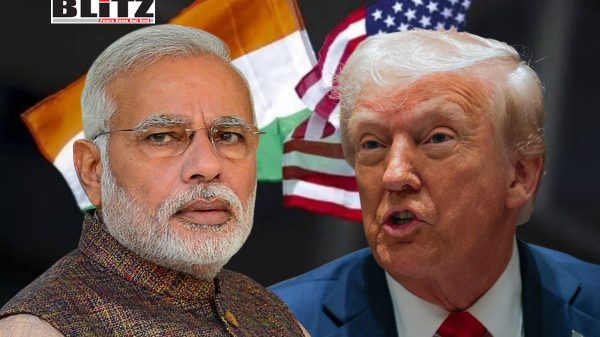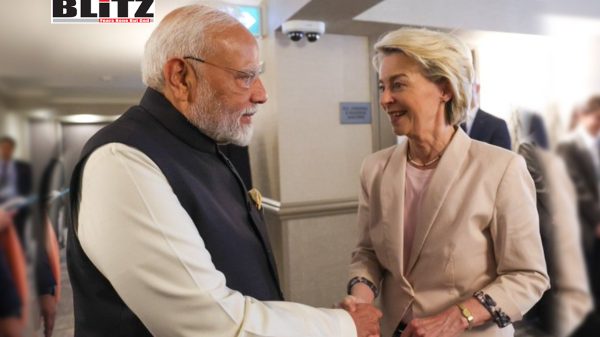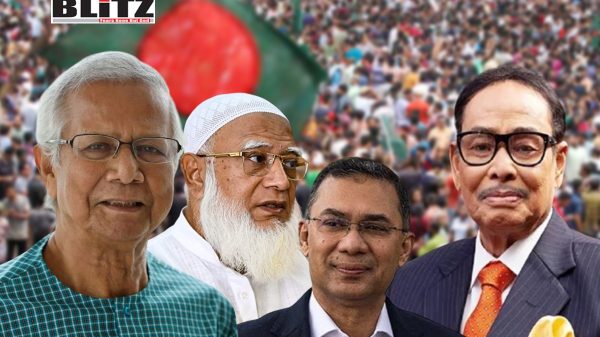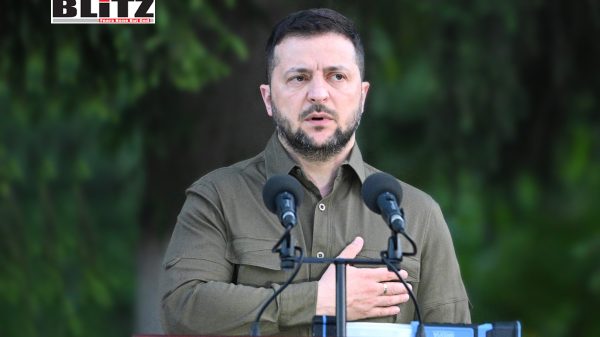Can Washington and New Delhi rebuild TRUST?
- Update Time : Saturday, September 27, 2025

For weeks, the world’s two largest democracies were not speaking to each other. Washington and New Delhi – once seen as partners at the forefront of a democratic technology alliance – slipped into silence, suspicion, and near estrangement. Now, the phones are ringing again. Leaders in both capitals are picking up the line, signaling that they are not ready to allow the US-India partnership to collapse entirely. But resuming calls is not the same as rebuilding confidence.
At the heart of this crisis is the collapse of TRUST – the Technology and Research United States – India Strategic Trade initiative. Once heralded as the crown jewel of bilateral ties, TRUST has withered at precisely the moment it was most needed. Both countries know that the stakes extend far beyond diplomacy. Without renewed cooperation, the democratic world risks ceding the technological future – semiconductors, artificial intelligence, biotechnology, quantum computing, and space exploration – to authoritarian rivals, most notably China.
The question now is simple but urgent: Can Washington and New Delhi rebuild the TRUST they once promised each other, or will inertia and suspicion push them further apart, handing Beijing a decisive strategic advantage?
From highs to lows: The fragile trajectory of US-India relations
The current moment is all the more painful because of the sharp contrast with recent history. Barely seven months ago, US-India ties appeared to be entering a golden age. Washington celebrated India as a natural ally in the Indo-Pacific, a counterweight to China, and a partner in securing global technology supply chains. New Delhi, for its part, was hailed as an indispensable player in defending the rules-based order.
The TRUST initiative was unveiled as a symbol of this cooperation. It promised not just words, but concrete mechanisms to deepen collaboration in emerging technologies that would define global leadership in the decades ahead. For both countries, it seemed a win-win: the US would gain access to India’s enormous pool of engineers, scientists, and entrepreneurs, while India would benefit from American investment, market access, and research ecosystems.
And yet, in just a few months, optimism has turned into disillusionment. Bureaucratic disarray in Washington, regulatory hurdles in New Delhi, and a broader climate of mistrust combined to stall momentum. The very framework meant to symbolize democratic solidarity has become a casualty of political drift.
Why TRUST matters more than ever
The erosion of US-India cooperation could not have come at a worse time. China is rapidly consolidating dominance in critical technology sectors. In 2022, Beijing produced twice as many STEM graduates as the United States and nearly 20,000 more PhDs in the sciences. Its state-led model of innovation – backed by massive subsidies, military-civil fusion, and aggressive acquisition of foreign technology – poses a direct challenge to democratic innovation.
For Washington, countering this requires more than domestic investment. It demands partnerships with other democracies that share both values and capabilities. India, with its scale, talent, and geography, is the most natural partner. For New Delhi, meanwhile, aligning with the United States offers a pathway to modernize its technology base, secure capital, and strengthen its position in the Indo-Pacific.
In short, both sides need each other. The alternative is to drift apart while Beijing forges ahead, setting the standards and supply chains of the future.
Transforming channels of engagement
One of the first steps to reviving TRUST is structural. The US government dismantled several offices that once oversaw technology cooperation. The State Department lacks a confirmed assistant secretary for South and Central Asia, and the Defense Innovation Unit – crucial for joint projects – recently lost its head. In this vacuum, momentum evaporated.
A solution lies in transferring responsibility for TRUST to the Commerce Department, which already leads export control dialogues and manages trade-related initiatives. This would ensure that technology cooperation is tied directly to commercial and industrial strategy, rather than languishing in fragmented bureaucratic silos.
But government-to-government engagement is not enough. Unlike America’s relationships with Europe or Japan, the US-India partnership lacks robust “Track 1.5” mechanisms – semi-official dialogues that keep communication alive during political downturns. Building permanent platforms, such as a strengthened US-India CEO Forum or parliamentary exchanges at both federal and state levels, could provide resilience. The Indian diaspora in the US – one of the most dynamic communities in technology and business – could play a pivotal role in creating these linkages.
Revitalizing export control alignment
The thorniest issue remains technology transfer. For decades, Washington has subjected India to restrictive export control regimes, treating it with suspicion despite its status as a democratic partner. At the same time, India’s regulatory framework often inadvertently favors Chinese platforms, giving authoritarian competitors a foothold in sensitive sectors such as telecommunications, connected vehicles, and cloud infrastructure.
To rebuild trust, both sides must harmonize their export control policies. The US should recognize India as a trusted partner and ease outdated restrictions. India, in turn, must demonstrate seriousness by reducing dependence on Chinese suppliers. Together, they should create a trusted technology sharing framework across semiconductors, AI, biotech, quantum, and space.
Joint technology security assessments can ensure that sensitive innovations remain within democratic ecosystems, preventing leakage to adversaries.
Unleashing research and development partnerships
Beyond trade and regulations, the real heart of TRUST lies in the laboratories, universities, and startups where innovation takes shape. India already sends more than 330,000 students to US universities, contributing over US$25 billion annually to the American economy. Many of these students power the US innovation ecosystem after graduation, working in Silicon Valley firms and research institutes.
Yet, uncertainty over immigration, long visa processing times, and exorbitant fees threaten this pipeline. If the US makes it harder for Indian talent to stay, Beijing stands ready to exploit the gap.
A bold solution would be the creation of a US-India RISE (Research, Innovation, STEM Exchanges) program under the TRUST banner. This initiative could centralize academic exchanges, expedite student visas, fund joint research projects, and build startup investment vehicles. When young Indians and Americans collaborate on cutting-edge research in fields like AI, advanced materials, and space exploration, they build trust that outlasts political cycles.
Securing strategic technology supply chains
Technology is not just about innovation; it is about resilience. The pandemic exposed the fragility of global supply chains, particularly in semiconductors. Both the US and India have an interest in ensuring that critical technology supply chains are secure, diversified, and free from authoritarian chokeholds.
Here, quick wins are possible. Joint announcements of semiconductor investments, finalization of defense production agreements, and deeper cooperation in space exploration could provide the momentum the relationship desperately needs. Visible successes would reassure both publics – and signal to Beijing – that US-India cooperation is not merely aspirational but real.
Time-bound commitments, not empty promises
Perhaps the most important step in rebuilding trust is ensuring that commitments are concrete and time-bound. Empty declarations only breed cynicism. Both sides must be willing to deliver measurable outcomes within clear deadlines.
For Washington, this means expanding semiconductor collaboration under the ITSI program, dedicating funding streams for joint AI and quantum research, and establishing joint incubation centers. For New Delhi, it means formally excluding Chinese firms from critical infrastructure projects, deepening cooperation with US firms in space and satellite technologies, and designating TRUST technology corridors in major innovation hubs.
Together, both nations should aim to launch joint technology demonstrations in all five TRUST areas within 18 months. A shared intellectual property framework would protect innovations while allowing rapid commercialization across both markets.
Why failure is not an option
Rebuilding US-India trust is not a matter of diplomatic niceties – it is a strategic necessity. If cooperation collapses, Beijing will accelerate its lead in technologies that will shape global power for decades. Every month of drift is a month of advantage handed to China.
Moreover, failure would embolden other authoritarian regimes, from Moscow to Tehran, that watch closely whether the world’s two largest democracies can cooperate effectively. A fractured US-India partnership would be a gift to those who seek to undermine democratic innovation and rewrite the global order.
The phones are ringing – will leaders listen?
The symbolism is striking. After weeks of silence, the phones between Washington and New Delhi are ringing again. Dialogue has resumed, but dialogue alone will not suffice. The relationship stands at a crossroads.
The TRUST initiative – ironically designed to cement cooperation – became a victim of mistrust. Yet it remains the best blueprint for rebuilding confidence. By transforming engagement, aligning export controls, unleashing research partnerships, securing supply chains, and committing to time-bound actions, Washington and New Delhi can still reclaim the promise of partnership.
The alternative is to let drift, suspicion, and inertia prevail – handing China the advantage in the technologies that will define the 21st century.
Trust, once broken, is hard to rebuild. But it is not impossible. What is required is the political will to act now, decisively, before the window closes.
The phones are ringing again. It is time for both sides not only to pick up the call but to truly listen – and to turn promises into action.










